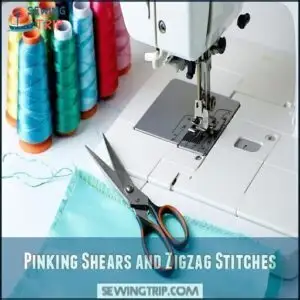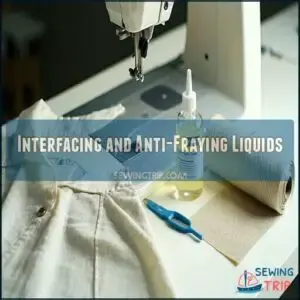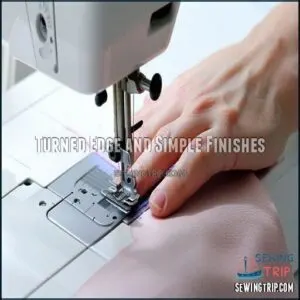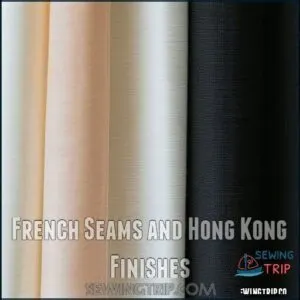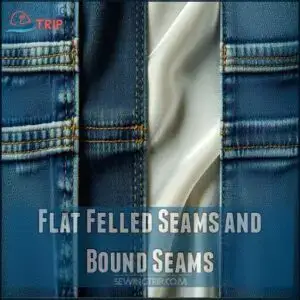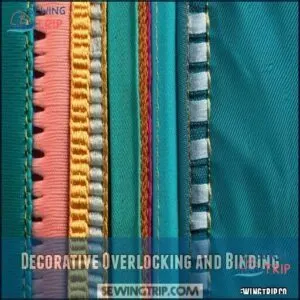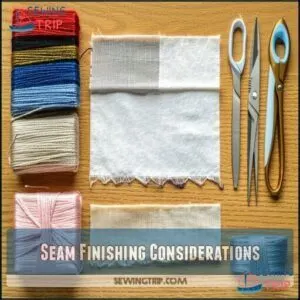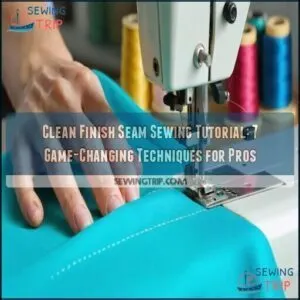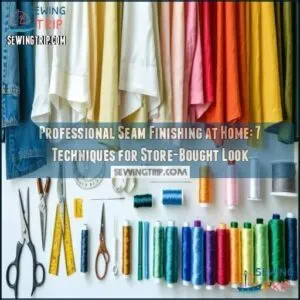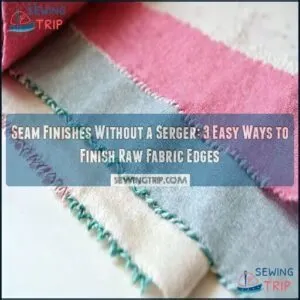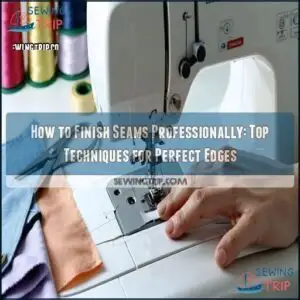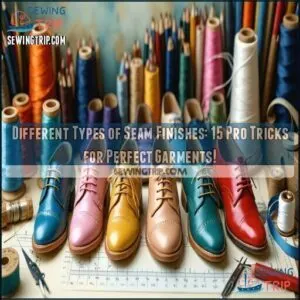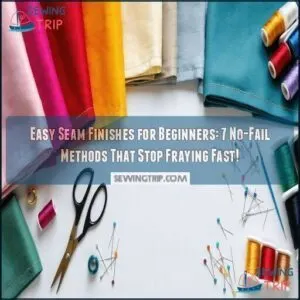This site is supported by our readers. We may earn a commission, at no cost to you, if you purchase through links.
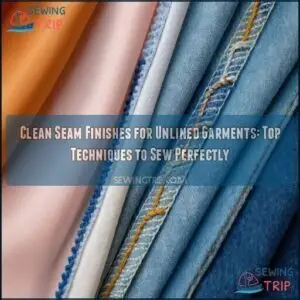 Clean seam finishes for unlined garments keep your work polished inside and out.
Clean seam finishes for unlined garments keep your work polished inside and out.
French seams are perfect for lightweight fabrics, enclosing raw edges neatly. For a hand-finished look, the Hong Kong finish adds a touch of couture by binding seams with bias tape.
If you’re short on time, zigzag or three-thread overlock stitches stop fraying fast. Pinking shears cut edges with a classic, vintage vibe.
Flat-felled seams work beautifully on sturdy fabrics like denim, creating strength and cleanliness in one go. The finish you choose depends on your fabric, time, and tools—like picking the right hat for the occasion, which can give your work a touch of couture.
Table Of Contents
Key Takeaways
- Match seam finishes to fabric type and weight—French seams work for lightweight and sheer fabrics, while flat-felled seams are ideal for heavy-duty materials.
- Use basic tools like pinking shears or zigzag stitches for quick, effective fray prevention without fancy equipment.
- Advanced techniques like Hong Kong finishes and serging add a polished, professional look to unlined garments.
- Consider seam location and garment stress points—reinforce high-wear areas and choose finishes that combine durability with style.
Choosing Seam Finishes
When choosing seam finishes, think about your fabric type, weight, and how much it frays.
Choose seam finishes based on fabric type, weight, and fraying to achieve durability and a polished look.
Match the finish to your equipment and the time you’ve got for a polished result.
Fabric Type and Seam Finish Suitability
The fabric type makes or breaks your seam finish choice.
Lightweight fabrics like chiffon need French seams for fray-free results, while tight-weave fabrics handle zigzag stitches well.
Knit fabrics rarely ravel, but curling edges may need a serger.
Sheer fabrics benefit from enclosed finishes. Match the fabric’s fraying tendency and weave tightness to the technique for clean, professional seams.
Considering Fabric Weight and Opacity
Working with fabric weight and opacity means understanding your material’s personality.
Lightweight fabrics like chiffon handle French seams well.
Sheer fabrics need finishes that hide raw edges neatly.
For sturdier, heavyweight fabrics, flat-felled seams shine.
Always consider these factors:
- Lightweight fabrics demand delicate finishes for better drape.
- Opaque fabrics hide stitching imperfections.
- Heavyweight fabrics need stronger, durable techniques.
Seam Location in Garment
Seam location impacts your finish choice, especially at stress points like pockets, waistbands, and facings.
Visible seams on coat interiors or shirts demand clean finishes for a polished look.
For hems, consider the garment’s aesthetic and reinforcement needs.
Sturdy finishes work best for high-wear areas, while lighter options suit less demanding spots.
Always match function with style!
Available Equipment and Time Constraints
Deadlines and minimal tools? No problem. A basic sewing machine handles most seam finishing techniques, but serger alternatives like zigzag stitches or pinking shears work wonders on unlined garments.
For speed techniques, try anti-fraying liquids or simple turned edges. Beginners can easily master these options while meeting tight project deadlines without splurging on fancy sewing tools like sergers.
One such technique involves turned and stitched seams for stable fabrics. Keep it simple!
Basic Seam Finishing
You don’t need fancy tools to create clean, professional seams.
With basic techniques like pinking shears, zigzag stitches, and turned edges, you can protect your fabric from fraying.
While keeping your project simple and polished, you can achieve a professional finish with these basic techniques.
Pinking Shears and Zigzag Stitches
When clean edges matter but time’s short, pinking shears and zigzag stitching are your go-to tools.
The pinked seam finish stops fraying with zigzag-edged precision—great for lightweight fabrics.
Zigzag versatility shines on curved seams, adding edge protection with adjustable stitch density.
You can find various fabric options for these shears.
Together, these methods keep fabrics neat and durable without fancy equipment, perfect for quick, polished results.
Interfacing and Anti-Fraying Liquids
For polished seams, try interfacing and anti-fraying liquids. These simple tools keep fabric edges smooth and durable.
Here’s how:
- Choose woven interfacing for edge stabilization.
- Apply anti-fraying liquid to raw edges for precise fraying prevention.
- Test these products on fabric scraps to check for durability.
- Seal small seams with a steady liquid application.
For lightweight fabrics, consider using pinking shears method for a quick finish.
Protect seams effortlessly!
Turned Edge and Simple Finishes
If you’re after quick techniques for beginner projects, try a turned edge.
Fold the raw edge under by 1/4 inch, press firmly, and stitch close to the fold. It’s perfect for clean seam finishes in unlined garments. This method balances edge durability and minimalist sewing.
| Benefit | Fabric Suitability | Skill Level |
|---|---|---|
| Prevents fraying | Lightweight cotton | Beginner-friendly |
| Clean aesthetics | Medium linen | Easy to master |
| Quick to sew | Sheer fabrics (chiffon) | Accessible |
| Durable edges | Tighter weaves | Great for practice |
Advanced Seam Techniques
You’ll elevate your sewing skills with advanced seam techniques that add both durability and a polished finish.
From French seams to bound edges, these methods guarantee clean, professional results for unlined garments, utilizing techniques such as French seams to achieve this.
French Seams and Hong Kong Finishes
Let’s talk finesse: French seams and Hong Kong finishes elevate unlined garments with clean seam finishes.
French seams shine with delicate fabrics, offering seam encasement for durability and elegance.
French seams create a polished look, encasing raw edges beautifully for added durability and timeless elegance.
Hong Kong finishes, perfect for heavier fabrics, use bias binding for couture aesthetics.
- Ideal for sheer fabrics or heavy materials
- Adds durability factors
- Great for durability and style
- Enhances fabric sheerness
Flat Felled Seams and Bound Seams
Flat felled seams and bound seams stand out for strength and style.
Flat felled seams, perfect for jeans, enclose raw edges tightly, adding durability.
Bound seams use bias tape binding to wrap edges neatly and stylishly.
| Seam Type | Durability Comparison | Aesthetic Applications |
|---|---|---|
| Flat Felled Seam | Strong, industrial uses | Casual, sporty looks |
| Bound Seam | Moderate, sewing machines | Formal, custom finishes |
The table highlights the aesthetic applications and durability comparison of each seam type, providing a clear overview of their uses.
Decorative Overlocking and Binding
Much like flat-felled seams, decorative overlocking and binding let you add flair while keeping edges pristine.
Overlock threads create a polished, serged seam finish, while binding with bias tape transforms rough edges into custom seams.
For unique seam finishes, consider using specialized thread options.
Try a Hong Kong seam for professional results or experiment with binding styles to match your garment’s personality.
These techniques balance durability with edge flair beautifully, providing a way to add custom seams and achieve professional results.
Specialized Finishes and Equipment
You’ll need the right tools to create polished, durable seams for unlined garments. From sergers to blind hem feet, specialized equipment helps you achieve professional results with ease.
Serger Machine Finishes and Overlock Machines
A serger transforms your sewing by combining speed and precision.
With serger machine finishes, overlock tension and differential feed guarantee flawless results.
Overlock machine finishes are ideal for tough tasks like industrial overlock projects or decorative serging.
Properly maintained, a serger creates durable, professional seams.
Differential feed prevents puckering on various fabrics.
Mastering overlock stitch techniques adds polish while overlocking lightweight and stretchy fabrics effortlessly, ensuring a professional finish.
Blind Hem Foot and Couture Finishes
Want invisible hems with couture durability? A blind hem foot is your go-to for unlined garment seams with a professional polish.
This tool guides stitches perfectly for clean seam finishes that scream couture-quality. You can find a variety of options online.
- **Works wonders for trousers, curtains, and jackets.
- **Creates nearly invisible stitches for a sleek look.
- **Pairs perfectly with bound or Hong Kong seams.
Three-Thread Overlock and Quick Finishes
A three-thread overlock seam finish combines speed with overlock durability, making it a go-to for clean seam edges.
It excels on curved seams, thanks to adjustable thread tension and differential feed.
Serging prevents fraying while staying cost-effective.
Unlike zigzag seam finishes, this method delivers a polished look with less bulk.
Perfect for lightweight fabrics needing fray prevention and efficiency.
Seam Finishing Considerations
When choosing a seam finish for unlined garments, think about the fabric type, weight, and how it will be used.
The right finish prevents fraying, adds durability, and keeps your garment looking its best.
Zigzag Stitches and Serging Methods
Unlike specialized finishes, zigzag stitching offers unmatched versatility.
It’s a lifesaver for most fabrics, catching fraying threads with precision. Want more durability? A serger adds strength with efficient overlock stitch techniques, perfect for unlined garments.
While serging creates professional results, zigzag stitches shine as overlock alternatives—quick, reliable, and easy on curved seams.
Decorative serging also adds flair where needed.
Flatlocking and Rolled Hemming
Flatlocking adds a sporty, decorative touch to clean finish seams on unlined jackets.
Adjust your serger’s tension for smooth results, ensuring fabric compatibility.
Rolled hem variations work wonders for lightweight materials, keeping edges crisp with minimal bulk.
Use proper equipment options and practice tension adjustments to nail rolled hem seams, it’s all about precision and experimenting for flawless finishes.
Fabric Type and Seam Finish Durability
How do you pick the right seam finishing techniques for unlined jackets or garments? Consider the fabric type, stress points, and finish longevity.
Durable seam finishes increase garment lifespan by preventing fraying and unraveling.
- Fabric weave matters—tight weaves fray less.
- Some fibers are naturally tougher.
- Stress points need strong seams.
Lightweight fabrics suit French seams.
Thick fabrics handle flat-felled seams well.
Aesthetics and Professional Finishes
If you want your sewing projects to stand out, focus on seam appearance. Clean finish seams add couture detailing, boosting garment longevity and creating a professional look.
Seam finishing techniques like French seams or Hong Kong finishes guarantee a polished, professional quality.
To prevent fraying, consider using pinking shears effectively. These small details deliver a visual impact, turning simple garments into couture-quality pieces that last and impress.
Frequently Asked Questions (FAQs)
How do seam finishes affect garment drape?
Seam finishes directly impact garment drape by reducing bulk and keeping fabric edges smooth.
Clean finishes like French seams or serging maintain flow, while heavier methods can stiffen lightweight fabrics, changing how the garment moves with smooth edges.
Are clean finishes suitable for heavy-duty clothing?
Clean finishes can work for heavy-duty clothing, but they’re not always ideal.
For durable garments exposed to wear, serging or flat-felled seams provide better strength and longevity while still offering a polished look.
What tools assist with pressing seam finishes?
You might think pressing tools aren’t necessary, but they’re game-changers.
Use a hot iron, pressing ham for curves, and a seam roll for tight areas.
Don’t forget a pressing cloth to avoid shiny marks!
Can clean finishes work with stretchy fabrics?
Stretchy fabrics can absolutely work with clean finishes if you use foldover elastic or narrow zigzag stitching.
These techniques provide flexibility, prevent fraying, and add durability without compromising the fabric’s natural stretch and comfort, which is a key aspect of using clean finishes.
How do seam finishes handle frequent washing?
Frequent washing tests seam durability and finish quality.
Use techniques like serging, French seams, or bias-bound edges—they resist fraying over time.
Always prewash fabric, as untreated materials warp faster than a teenager’s plans, which is a key consideration for seam durability.
Conclusion
Imagine this scenario: you’ve just finished a light summer dress, and thanks to clean seam finishes for unlined garments, it looks flawless inside and out.
Choosing techniques like French seams for delicate fabrics or flat-felled seams for durability guarantees your garment lasts and looks professional.
With the right tools and a bit of care, your sewing always shines, whether you pick pinking shears for speed or Hong Kong finishes for a couture touch, each method enhances your project.


